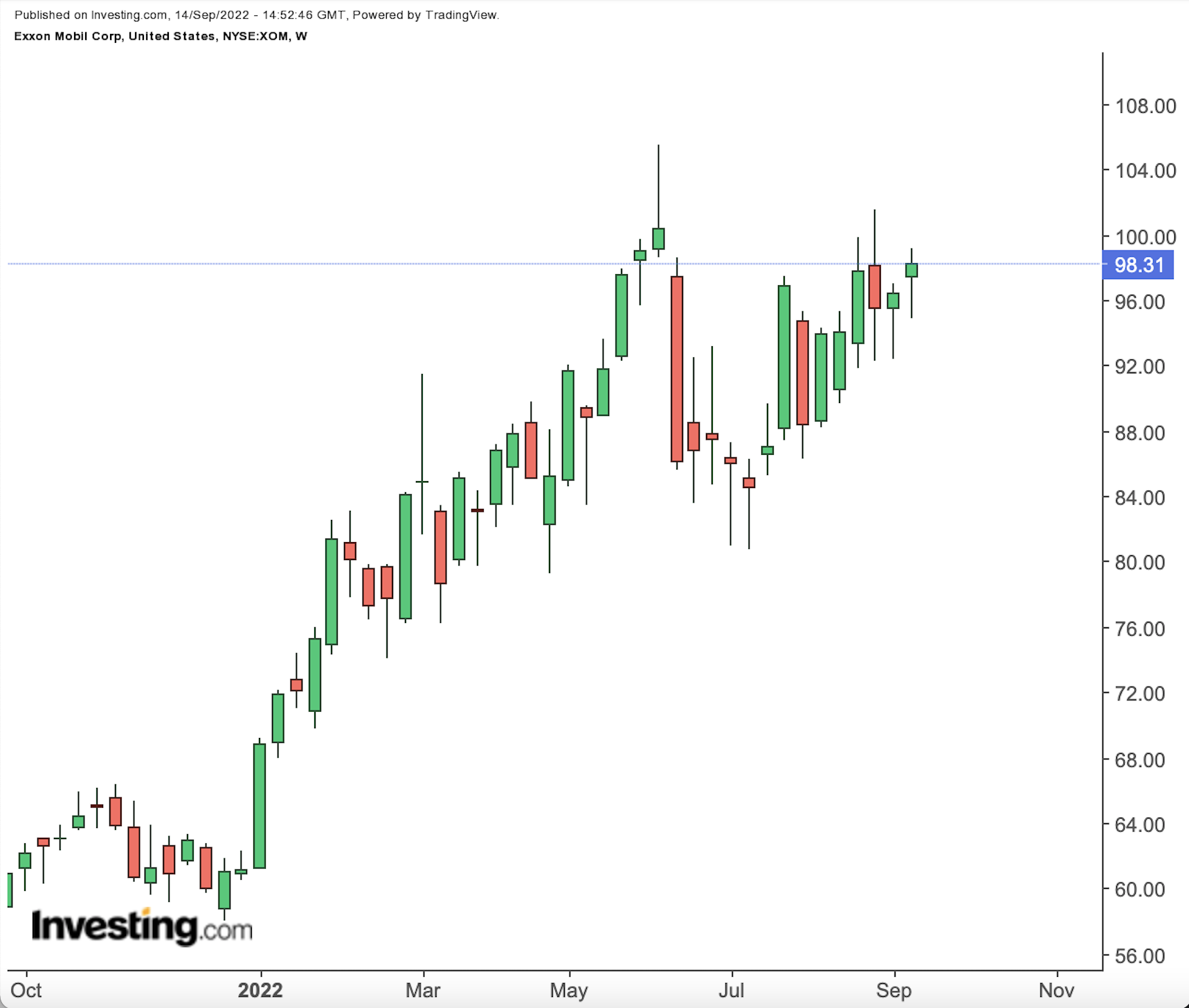- XOM has been the best-performing mega-cap stock of the past 12 months
- Higher oil prices have helped — but so have internal improvements
- Returns going forward likely won’t match those of recent years, but the ‘old’ Exxon Mobil appears to be back
So far this year, Exxon Mobil (NYSE:XOM) has gained a sharp 55.8%. Over the past 12 months, XOM has rallied 72%. Both measures are the best of any of the 33 mega-cap (market cap over $200 billion) stocks in the U.S. market.

Source: Investing.com
Obviously, energy prices have helped. Year-to-date, Brent crude oil prices have gained 41%. The Henry Hub natural gas spot price has more than doubled. But those strengths alone don’t explain all of the gains in Exxon Mobil stock.
After all, other integrated oil majors have similar tailwinds. But Chevron (NYSE:CVX) has gained ‘only’ 36% so far in 2022, and BP (LON:BP) (NYSE:BP) 19%.
The outperformance in XOM against peers, not just the broader market, is due, in part, to decisions Exxon Mobil itself has made. And there’s a strong case that the company, and the stock, will reap the benefits of those decisions for some time to come.
The Case Against XOM Stock
The case against XOM stock here is relatively simple. Clearly, there are real concerns about worldwide economic demand. And, generally speaking, when demand goes down, so do oil prices.
To some extent, macroeconomic risks are priced into the stock. XOM trades at just 10.4x trailing 12-month earnings. In other words, the market is projecting that current earnings are higher than the long-term average.
That makes some sense, and not just because of macro worries. Exxon’s refining business has had a blowout year so far, with margins “at very high levels,” per the company’s second-quarter conference call. Simply, in the second quarter, those margins added more than $1 per share in after-tax earnings.
Simply put, at its core XOM is a cyclical business. To be sure, the downstream (refining, distribution and fuelling) and chemicals segments provide some internal hedging: chemical profits, in particular, generally go up when the price of oil (a key input) goes down.
Still, this is a cyclical business, if a massive one. And it’s dangerous to buy a cyclical just because it’s “cheap” ahead of a downturn in the cycle. Worldwide economic conditions certainly suggest a real risk that a downturn is ahead.
Taking The Long View
Any investor owning XOM — or any energy play — right now is taking on the risk of lower oil prices. That’s a given. But the correlation of macroeconomic activity and oil prices might not be quite as strong as it once was.
After all, the price of oil is driven not just by demand, but by supply. And even before the Russian invasion of Ukraine, there were real questions about supply. Governments across the West continue to put pressure on oil producers.
The industry itself has pulled back as well. U.S. shale producers, in particular, were scarred by the collapse of the market last decade; they’ve generally focused on returning cash to shareholders rather than expanding production.
But as management has detailed of late, including on the Q2 conference call, Exxon has taken a different tack. It has invested in production, allowing it to increase volumes to take advantage of the recent surge in oil prices. It has added to its refinery capacity, while the novel coronavirus pandemic shuttered other facilities.
This is not a case of Exxon Mobil simply benefiting from higher energy prices. There’s been a strategy here, one that certainly seems more on point since the surprising win by activist Engine No 1 last year.
Those business improvements aren’t necessarily going anywhere. Nor are the external market conditions being seen at the moment.
Producers in the U.S. and elsewhere still haven’t really ramped production. Exxon’s refinery business seems well-positioned. The chemicals business is down sharply this year, but profits still are more than double what they were in 2019.
And while the recent jump in oil prices seems like a shock, Brent crude actually is right about in the middle of its 10-year range. Excluding the early days of the pandemic — when oil futures famously turned negative — the low end of that range came last decade, when producers dramatically ramped their production. That seems unlikely.
At this valuation, as long as oil doesn’t plunge again, Exxon Mobil stock should at least hold up. This simply is a better business than it was — no matter what the crude price is.
Disclaimer: As of this writing, Vince Martin has no positions in any securities mentioned.
